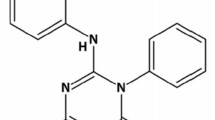Summary
The stereoselective disposition of mephenytoin was characterized after an intravenous bolus dose of racemic mephenytoin to rats being infused with 50% polyethylene gycol 400/50% saline via the jugular and hepatic portal vein. No significant influence on mephenytoin disposition was noted due to the site selected for the administration of the 50% polyethylene gycol 400 solution. The mean ( ± S D ) clearance of R- and S-mephenytoin were 171 ± 5 8 ml/hr (R) and 110 ± 37 ml/hr (S), and the mean ( ± S D ) volumes of distribution were 325 ± 75 ml (R) and 3 5 9 ± 72 ml (S). The clearance of R-mephenytoin was significantly larger than the clearance of S-mephenytoin, but this stereoselective difference is of opposite stereochemistry and of much smaller magnitude than the stereoselective difference reported for these enantiomers in man. The difference in the volumes of distribution of R- and S-mephenytoin was not significant.
Similar content being viewed by others
References
Ruskin D.B. (1948): Fulminating dermatitis bullosa medicamethose due to “Mesantoin”. JAMA137, 1031–1035.
Fetterman J.L. and Victoroff V.M. (1949): Mesantoin in epilepsy, a three year study. Dis. Nerv. Syst.10, 355–358.
Abbott J.A. and Schwab R.S. (1954): Mesantoin in the treatment of epilepsy: A study of its effect on the leukocyte count in seventy-nine cases. N. Engl. J. Med.250, 197–199.
Butler T.C. (1952): Metabolic demethylation of 3-methyI-5-ethyl-5-phenyl hydantoin (Mesantoin). J. Pharmacol. Exp. Ther.104, 299–308.
Troupin, A.S., Friel, P., Djvely, M.P. and Wilensky, A.J. (1979): Clinical pharmacology of mephenytoin and ethotoin. Ann. Neurol.6, 410–414.
Kupfer, A., Desmond, P.V., Schenker, S. and Branch R.A. (1982): Stereoselective metabolism and disposition of the enantiomers of mephenytoin during chronic oral administration of the racemic drug in man. J. Pharmacol. Exp. Ther.221, 590–597.
Kupfer A., James R., Carr K. and Branch R.A. (1982): Analysis of Hydroxylated and demethylated metabolites of mephenytoin in man and laboratory animals using gas-liquid chromatography and high-performance liquid chromatography. J. Chromatogr.232, 93–100.
Shimada T. and Guengerich F.P. (1985): Participation of a rat liver cytochrome P-450 induced by pregnenolone 16-carbonitrile and other compounds in the 4-hydroxylation of mephenytoin. Mol. Pharmacol.28, 215–219.
Webster L.K., Jones D.B., Mihaly G.W. and Smallwood R.A. (1984): Effect of omeprazole and polyethylene glycol-400 on antipyrine elimination by the isolated perfused rat liver. J. Pharm. Pharmacol.36, 470–472.
Wedlund P.J., Sweetman B.J., McAllister C.B., Branch R.A. and Wilkinson G.R. (1984): Direct enantiomeric resolution of mephenytoin and its N-demethylated metabolite in plasma and blood using chiral capillary gas chromatography. J. Chromatogr.307, 121–127.
Wedlund P.J., Herman R.J. and Wilkinson G.R. (1983): Diurnal oscillations in drug elimination: The use of long term infusions in rats to examine the effects of constant lighting. The Pharmacologist25, 3.
Chang S.-L., Emmick K., Wedlund P.J. (1986): Characterization of Antipyrine autoinduction in the rat utilizing a new microsampling technique for serial blood sample collections. J. Pharm. Sei.75, 456–458.
Akrawi S.H. and Wedlund P.J. (1987): Method for chronic portal vein infusion in unrestrained rats. J. Pharmacol. Methods17, 67–74.
Akrawi S.H. and Wedlund P.J. (1986): A problem with quantitation of mephenytoin enantiomers due to chiral interference from its N-demethylated metabolite. J. Chromatogr.381, 198–200.
Benet L.Z. and Galeazzi R.L. (1979): Noncompartmental determination of the steady-state volume of distribution. J. Pharm. Sei.68, 1071–1074.
Arola L.L., Palou A., Remesar X., Herrera E. and Alemany M. (1980): Effect of stress and sampling site on metabolite concentration in rat plasma. Arch. Int. Physiol. Biochim.88, 99–105.
Boobis A.R. and Powis G. (1973): The effects of catecholamines on drug metabolism in the rat. Biochem. Soc. Trans.1, 849–852.
Wedlund P.J., Aslanian W.S., Jacqz E., McAllister C.B., Branch R.A. and Wilkinson G.R. (1985): Phenotypic differences in mephenytoin pharmacokinetics in normal subjects. J. Pharmacol. Exper. Ther.234, 662–669.
Inaba T. (1986): Genetic Polymorphism of mephenytoin metabolism. In Kalow W., Goedde H.W., Agarwal D.P., eds. Ethnic Differences in Reactions to Drugs and Xenobiotics. Alan R. Liss, Inc., pp. 139–156.
Author information
Authors and Affiliations
Rights and permissions
About this article
Cite this article
Akrawi, S.H., Wedlund, P.J. Mephenytoin stereoselective elimination in the rat: I. enantiomeric dispostion following intravenous administration. European Journal of Drug Metabolism and Pharmacokinetics 14, 195–200 (1989). https://doi.org/10.1007/BF03190099
Received:
Issue Date:
DOI: https://doi.org/10.1007/BF03190099




